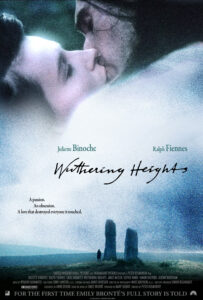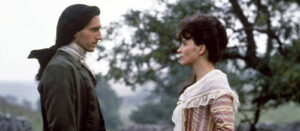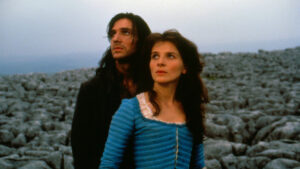“Wuthering Heights” – Love against the Rules

Title: “Wuthering Heights”
Release Date: 1992
Director: Peter Kosminsky
Cast: Ralph Fiennes, Juliette Binoche, Janet McTeer, Sophie Ward, Simon Sepherd, Jeremy Northam, Jason Riddington
“Wuthering Heights”, Emily Brontë’s only and also outstanding novel, has been transferred to the big screen several times. Peter Kosminksky’s adaptation, however, is the most faithful version of the famous story of Katherine and Heathcliff’s romantic yet destructive love, which proved stronger than all social and moral rules. Excellent performances by Juliette Binoche and Ralph Fiennes perfectly captured the atmosphere of this half-gothic and frenetic, half-Victorian tale of two souls forever connected by an invisible knot that neither cultural oppression nor death managed to break.
“Wuthering Heights” – from novel to adaptation
“Wuthering Heights” is Emily Brontë’s only novel, published in 1847 under the male pseudonym Ellis Bell. A few months earlier, a novel by the author’s older sister Charlotte, “Jane Eyre,” was published under the same name. Both writers, as well as a third sister, Anne, were the daughters of a poor English pastor, trying to reconcile a literary vocation with intensive work in difficult material conditions. Unlike the story of Jane Eyre, “Wuthering Heights” did not initially meet with the approval of readers and the public.
Contributing to this was the novel’s peculiar depiction of the world presented, in which the author questioned rather than affirmed the principles of the established Victorian order. For she showed a story of passionate love, deaf to all social and religious restrictions. Her characters are figures that escape simple moral judgments. In particular, the portrait of a woman who has nothing to do with good upbringing and the manners of a submissive lady stands out here, which shocked readers at the time and still violates cultural standards today.

“Wuthering Heights” has been adapted by the cinema several times. Among the most important screen adaptations are the 1939 version starring Laurence Olivier and Merle Oberon, directed by William Wyler, and Luis Buñuel’s picture, starring Jorge Mistral and Irasema Dilian. The 1993 English adaptation by Peter Kosminsky, on the other hand, is the picture most consistent with the novel original.
“Wuthering Heights” – what is the story about?
The plot of “Wuthering Heights” takes place over a period of 30 years at the turn of the 18th century in North Yokrshire. The protagonists of the story are two families: the noble and less wealthy Earnshaw family living in the eponymous Wuthering Heights, and the aristocratic Linton clan based in Drozd’s Nest. The story has a narrative double bracket. It begins and ends with the writer herself visiting the old, abandoned castle, at which point the whole story is born in her imagination. The second bracket, in turn, is the moment when the tenant of the Drozd’s Nest appears in Wuthering Heights, accidentally learning about the sad history of the characters.
Therefore, we go back several decades, when Mr. Earnshaw brings back from a long journey an orphaned boy named Heathcliff, who becomes the half-brother of his biological children Cathy and Hindley (Jeremy Northam). After the death of his father, Catherine’s brother throws Heathcliff out of the house and turns him into a despised farmhand. The girl feels very sorry for him and spends every free moment with him. The two get very close to each other and become two soulmates. One evening together they sneak into the Mockingbird Nest to peep at the Lintons. When they are caught, Heathcliff manages to escape and Cathy is attacked by dogs. She spends several months with the Lintons, which completely changes her.
The heroine begins to compare the uncouth Heathcliff with the fashionably dressed and wealthy Edgar (Simon Shepherd), whom she eventually marries. Meanwhile, the spurned orphan flees Wuthering Heights, and when he returns two years later as a wealthy man, he buys out his brother Cathy’s debts and the entire family estate. Nevertheless, Cathereine does not leave her husband, and Heathcliff marries Edgar’s sister, whom he makes unhappy. Cathy, meanwhile, dies after giving birth to her daughter. Eighteen years pass, and the owner of Wuthering Heights, blazing with a lust for revenge, deceitfully lures Cathy’s daughter to the manor and forces her to marry his son, thus taking over her estate. On the evening that the new tenant of the Mockingbird Nest shows up at the hero’s house, Wuthering Heights is haunted by Catherine’s ghost, followed by Heathcliff. Cathy’s daughter and her cousin fall in love with each other and are able to lead a happy life together unhindered.

“Wuthering Heights” as a romantic gothic story
“Wuthering Heights” is a movie that, like the novel, contains many Gothic elements. The leading role here is played by a mysterious and dark space. It is created by both cultural elements (the gloomy castle of Wuthering Heights) and nature (the vast, windy and misty moors and the stony Yorkshire landscape). It plays a role in building the gothic atmosphere of the film, but it also serves as a projection of the interior of the characters and their unbridled love. This is indicated not only by the course of the plot, but also, for example, by Cathy’s speech. After all, the girl compares her affection for Edgar to forest foliage that will disappear with the coming of winter, contrasting it with her affection for Heathcliff, who is like an indestructible rock.
Kosminsky’s film also features supernatural elements, i.e. Heathcliff’s magical and prophetic abilities, the metaphysical bond connecting the characters or Catherine’s ghost. Gothicism is a typical feature of a romance novel, which is also faithfully reflected in the film adaptation. Another characteristic element of “Wuthering Heights” is freneticism, that is, the presence of elements of madness and amoral behavior of the characters. This is particularly evident in the case of the demonic Heathcliff abusing his own wife or digging up the corpse of his beloved. Also incompatible with the standards of the image of a positive heroine is in many situations the behavior of Cathy, who outright psychologically torments her husband, accuses him of cowardice or exposes him to physical violence on the part of Heathcliff.
The two faces of Catherine in “Wuthering Heights” – moorings
Cathy’s two different relationships with men in “Wuthering Heights” say a lot about the nature of the heroine and reflect her dual nature. They are, so to speak, portraits of the interior and exterior of the character. The character of Catherine brilliantly created by Juliette Binoche is a girl completely different from the model of a well-bred maiden of the Victorian era. From childhood she is wild, wayward and bold. Instead of getting an education, like a boy she roams the moors and loves to play tricks. This untamed nature of Cathy is emphasized by her hairstyle, in which she appears at the beginning of the film: the disheveled, tangled hair seems strangely incompatible with the standard image of young girls of the time.

Such a portrait of Cathy has a realistic motivation – the girl, due to the early death of her parents, did not receive a proper upbringing and was not taught manners. But it also has a deeper meaning: namely, it highlights the repressive role of culture in the formation of the female role model. After all, a woman, especially in the Victorian model, was supposed to be a passive, phlegmatic lady, decorating the house and obediently performing her duties. Not coincidentally, the wild setting that shapes Cathy’s nature is also the setting for her relationship with Heathcliff. From the beginning we have a love that goes beyond social norms, first as a misalliance, then as a violation of the institution of marriage.
Heathcliff himself appears as a fascinating and ambiguous character. Ralph Fiennes’ outstanding debut has provided him with excellent career prospects. Heathcliff, as performed by this actor, is a dark character and intriguing with his magnetic gaze of bright eyes. The character appears almost as a demon in love, whose only human emotion is a huge and mad love for Cathy. And this is a bond that nullifies all schemes and has existing norms for nothing. It is a love as invigorating as the wind from the ocean moors and as lasting as the rocky landscape of the Yorkshire mountains.
Catherine at Linton Castle in “Wuthering Heights”
Catherine from “Wuthering Heights,” however, has a second face as well. It is revealed, or rather constructed, during her stay at the Drozd’s Nest, when she experiences an infatuation with Edgar. It is then that the heroine acquires social savvy and becomes a Victorian lady. Her transformation is signaled by her elaborate hairstyle, silk outfits and gloves. The environment she inhabits also serves a significant function. It is not a gloomy, labyrinthine castle, but a tastefully decorated mansion. Everything has its definite place here, even nature has a completely different face than in Wuthering Heights. Namely, we see perfectly planned and manicured gardens – a space completely subordinated to rational human intentions.
Therefore, we have here a portrait of a heroine shaped by cultural requirements, which contrasts starkly with her natural predispositions. Cathy compares her previous status with the life she experiences in an aristocratic manor. The Lintons stand decidedly higher in the social hierarchy, and the heroine realizes that marriage to Edgar will be a class advance for her. She also begins to painfully see the difference between Heathcliff and the well-educated and wealthy Linton. A remarkably telling scene is Cathy’s return to Wuthering Heights and her greeting with her longtime companion. Heathcliff, shaking her hand, soils the heroine’s white gloves, and she looks at them with embarrassment. Later, she confesses to a servant that marriage to Heathcliff would be a humiliation for her.

Nevertheless, the change in Cathy’s personality turns out to be as impermanent as her love for Linton. Very soon after her marriage, the heroine realizes that she made a mistake in deceiving her true nature and begins to suffocate in the tight framework imposed on her. In one scene, we see her almost fainting as she reaches her bedroom window and tilts the window to feel the invigorating wind from the moors. Cathy’s inner conflict grows, culminating when she herself brings Heathcliff and Edgar into a clash. She then cynically scoffs at the cowardice of her husband, who, instead of seeing off the daredevil on his own, wants to call in servants for help.
“Wuthering Heights” and love free from cultural oppression
The price Cathy pays for betraying her nature, cultural requirements and religious principles is death. Catherine and Heathcliff’s love breaks all the norms of the Victorian world. It embezzles social hierarchy and traditional morality. This turn of events is already foreshadowed by a memorable Sunday, when the two, instead of listening to Bible verses, make fun of them, and then flee the house pursued by the curses of a preacher, calling their relationship the work of Satan. The demonic-lined nature of Cathy and Heathcliff’s relationship echoes back after the heroine’s death, when her beloved bursts into the Linton house at night, where the dead woman’s coffin is located.
The man’s vehement, tearful despair contrasts eloquently with her husband’s respectful yet cool farewell to Cathy. Linton places the marriage medallion in his wife’s hands, while Heathcliff snatches it away, challenging the very heavens to fight for his beloved. This is undoubtedly the most moving scene of “Wuthering Heights.” Heathcliff becomes the embodiment of Orpheus wanting to keep his love at all costs. Everything he does after Cathy’s death is aimed at keeping her soul on earth, even at the expense of her salvation. Years later, he digs up Cathy’s body to look at her face, which turns out to be intact. This confirms the supernatural relationship of the lovers, but also evokes associations of the heroine’s character with a gothic witch. Heathcliff’s unrelieved despair also hides a clear negation of the Christian bonds of marriage, which command fidelity to one’s spouse until death.
The heroes of “Wuthering Heights” do not respect this principle, and their love proves stronger even than physical annihilation. Therefore, in the end they are united – in another transcendent reality, free of constraints, where, amidst the windy moors, they fall into each other’s arms.
Literature:
M. Drabikowska, Subwersywność powieści „Wichrowe wzgórza” (1847) Elily Bronte na przykładzie postaci Katarzyny Earnshaw – szkic antropologiczny
